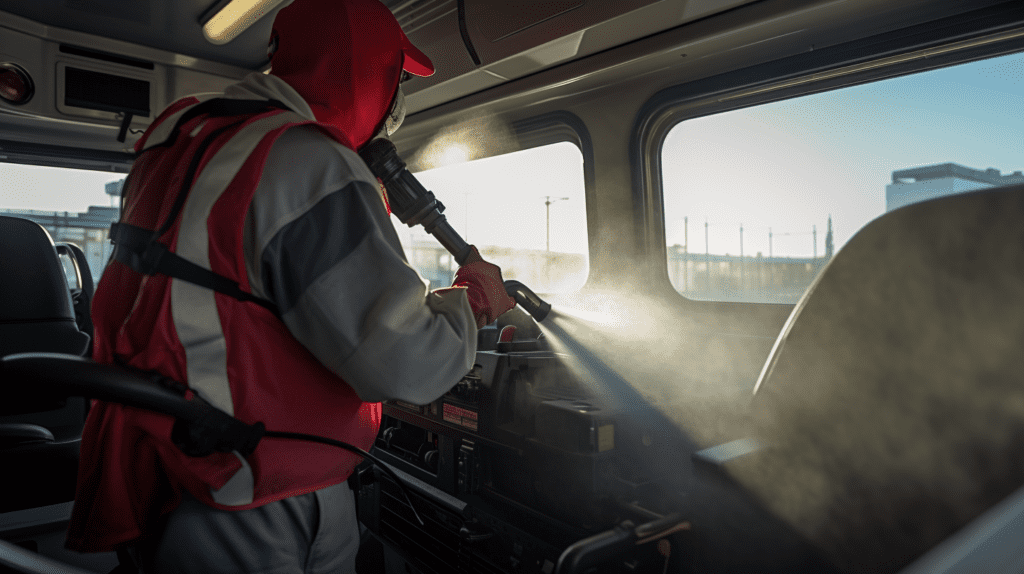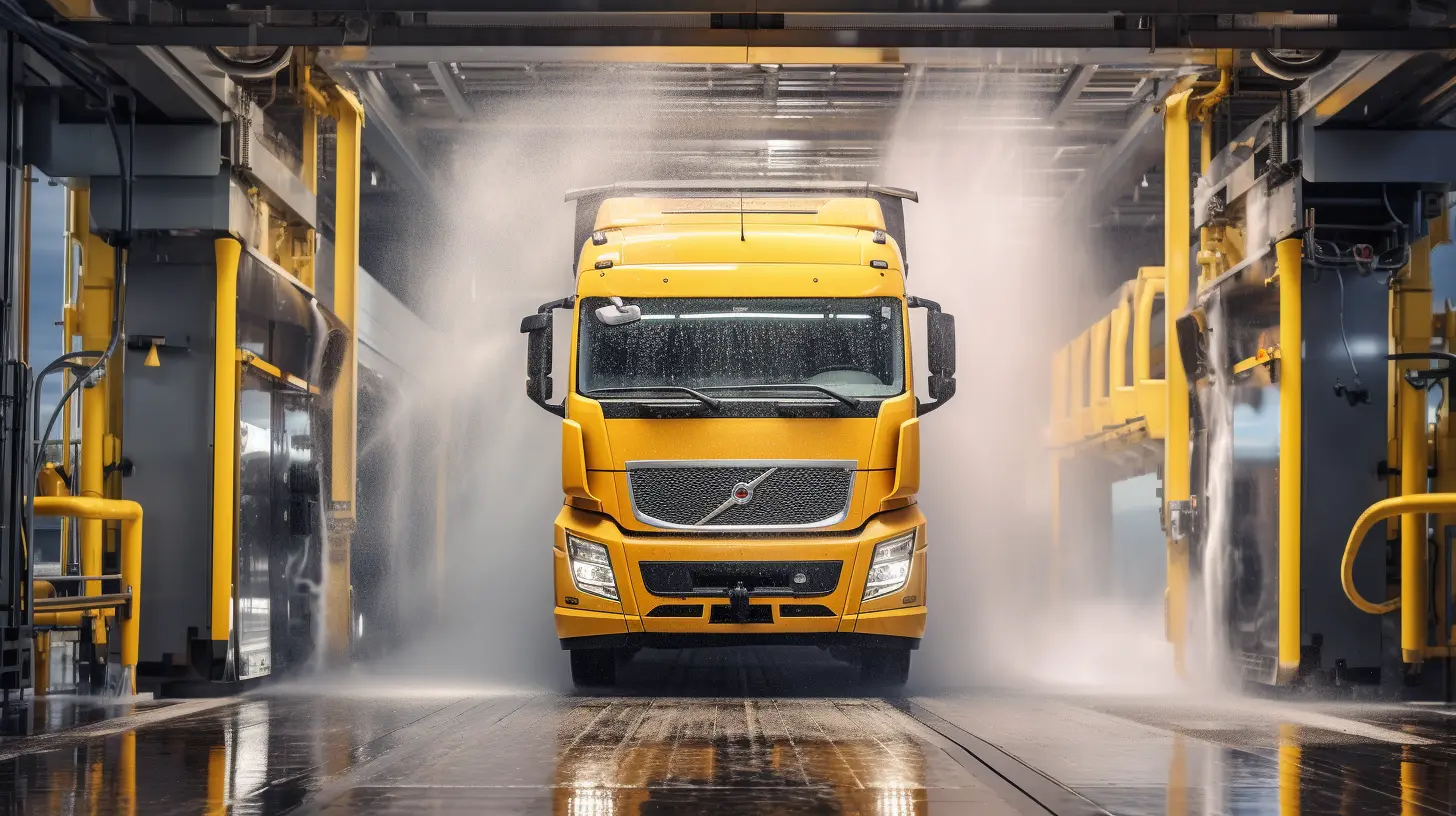Maintaining a fleet of vehicles is not just about ensuring they are operational; it’s also about presenting a professional image and ensuring the safety of both drivers and passengers.
Regular cleaning of fleet vehicles plays a crucial role in achieving these goals.
A clean vehicle not only reflects positively on your brand but also contributes to the longevity and reliability of the vehicles themselves.
Whether you’re managing a delivery service or a construction company, knowing how to clean fleet vehicles using fleet-washing chemicals effectively saves time and money.
Key Takeaways
- Plan Ahead: Gather all cleaning tools and products before starting to save time and ensure efficiency.
- Use Proper Techniques: Follow recommended cleaning techniques to avoid damaging vehicle surfaces.
- Choose the Right Tools: Select appropriate brushes, clothes, and cleaners for different parts of the vehicle.
- Focus on Interiors: Pay special attention to interior cleaning for a comfortable and healthy driving environment.
- Regular Maintenance: Implement a routine cleaning schedule to keep fleet vehicles in top condition.
- Go Green: Opt for eco-friendly cleaning products to reduce environmental impact.
1. Preparing for Cleaning

1. Designated Cleaning Area
A specific location for cleaning is essential. It helps in organizing the cleaning process efficiently. Choose a spot away from traffic and other activities. This ensures safety and focus during the task. The majority of cleaning spaces are built by taking all precautions.
Proper waste disposal is crucial. Set up containment measures to handle dirty water and debris. Use bins or containers to collect waste. This prevents pollution and keeps the area tidy.
2. Safety Precautions
Ensure vehicles are turned off before starting. It’s important they are parked safely on a flat surface. This reduces any risk of accidents during cleaning.
Use safety stands when working with raised components. These stands provide stability, preventing falls or slips. Always check that they are secure before proceeding.
2. Cleaning Techniques
1. One-Step Touchless Cleaning
First, apply a high pH (alkaline) detergent to the vehicle. This type of detergent, a degreaser and truck wash soap, helps break down dirt and grime as a pressure washing chemical. Use a sprayer to cover the entire surface evenly. Make sure to reach all areas, including hard-to-reach spots.
Let the detergent sit for a few minutes. This is called dwell time. It allows the cleaner to work on tough stains. Afterward, rinse the vehicle thoroughly with water. High-pressure rinsing ensures all dirt and detergent are removed.
2. Two-Step Touchless Cleaning
Begin by applying a low pH (acid) detergent to the vehicle’s surface. This step targets mineral deposits and brake dust. Use a sprayer for even coverage, just like in one-step cleaning.
Next, apply a high-pH detergent immediately after the low-pH one. This combination works effectively to remove both organic and inorganic residues. The two detergents, including truck wash soap, work together to lift dirt without scrubbing.
Allow both detergents some dwell time. Then rinse the vehicle thoroughly with water. High-pressure rinsing is key here too, ensuring no residue remains.
3. Tools and Products Needed

1. Commercial Pressure Washers
Commercial pressure washers are essential for fleet vehicle cleaning. Choose models with adjustable pressure settings. This allows you to clean different surfaces without damage. Hot water options are great for removing grease and grime. They make tough jobs easier. Ensure the washer is compatible with various detergents for best results.
2. Portable Cleaning Tools
Portable tools help clean vehicles on the go. Equip your fleet with compact, battery-operated vacuums. These are perfect for quick interior cleaning. Handheld steamers sanitize surfaces fast. They kill germs without chemicals. Collapsible buckets and squeegees make window cleaning easy anywhere.
3. Cleaning Agents
Different detergents suit different needs. Alkaline cleaners remove oils and fats effectively. Acidic ones tackle mineral deposits and rust stains. Eco-friendly options are available too. They protect the environment while keeping vehicles clean. Using them benefits both the fleet and nature.
4. Interior Cleaning Procedures

1. High-Touch Surfaces
Fleet vehicles often have many hands touching them. High-touch areas include the steering wheel, door handles, and gear shift. These spots gather germs quickly. It’s important to clean them often to keep the vehicle safe and healthy.
Use sanitizing wipes or sprays that contain at least 70% alcohol for these surfaces. Alcohol-based products kill most germs effectively. Make sure to wipe down all buttons and knobs too. This ensures every part is clean.
2. Deep Cleaning Techniques
Deep cleaning helps remove dirt and grime from seats, carpets, and dashboards. Start with vacuuming the seats and floor mats. This gets rid of loose debris like crumbs and dust. Follow up by using a fabric cleaner for cloth seats. For leather seats, use a special leather cleaner to avoid damage.
Carpets can be tricky because they trap dirt easily. A carpet cleaner with a brush attachment works well here. Scrub gently to lift stains without harming the material. Dashboards also need attention. Use a microfiber cloth with a gentle cleaner to wipe away dust and fingerprints.
5. Maintenance Best Practices
1. Regular Cleaning Schedule
A regular cleaning schedule keeps fleet vehicles in top shape. Establishing a routine for cleaning and sanitizing ensures that dirt and grime do not build up over time. This routine should include both the exterior and interior of the vehicles. Regular cleaning helps maintain the vehicle’s appearance and prolongs its life.
Drivers can follow a simple checklist. It might include washing the exterior, vacuuming the seats, and wiping down surfaces. Regularly checking and replacing air filters is also important. A clean vehicle is more inviting for drivers and passengers alike.
2. Preventive Measures
Preventive measures help spot minor issues before they escalate. By inspecting vehicles regularly, drivers can catch small problems early. This might include checking tire pressure or looking for any strange noises. Addressing these issues promptly can prevent costly repairs later on.
Corrosive substances like road salt can damage vehicles if not addressed. It’s crucial to wash off these substances quickly to protect the paint and metal parts. Regular inspections ensure that any signs of rust or corrosion are dealt with immediately. This keeps the fleet running smoothly.
6. Environmental Considerations
1. Eco-friendly Products
Using eco-friendly products is important. Regular cleaning products can harm the environment. They often contain harsh chemicals. These chemicals can pollute water and soil. Eco-friendly alternatives are safer. They break down naturally and don’t harm nature. Look for labels that say “biodegradable” or “non-toxic.”
Many companies offer green cleaning supplies. These products work well on fleet vehicles. They clean without leaving harmful residues. Some examples include plant-based soaps and vinegar solutions.
2. Wastewater Disposal
Disposing of wastewater responsibly is crucial. Dirty water from washing vehicles contains pollutants. It can have oil, dirt, and soap residues. If not handled properly, it can damage ecosystems.
Never dump wastewater into storm drains. These drains lead to rivers and oceans. Instead, use a designated disposal area. Some places have special systems for treating wastewater.
Consider setting up a filtration system at your facility. This system cleans the water before release. It removes harmful substances, making it safe for the environment.
3. Conversational Grammar
7. Summary
Keeping your fleet vehicles clean is important for their health, not just their looks. With the right tools and methods, you can easily handle dirt and grime.
Remember to clean the insides too; it’s just as important. Regular cleaning helps everything work well, and being eco-friendly is a bonus.
Now, it’s time to get to work and give your fleet some love. Use these cleaning tips to make your vehicles shine. If you have questions or need more help, just ask! Let’s keep those vehicles running smoothly and looking great. Your fleet’s future counts on it.
8. Frequently Asked Questions
1. How do I start cleaning my fleet vehicle?
Begin by gathering your tools and products. Think of it like assembling your team before a big game. Make sure you have everything ready, from soap to brushes, before diving in.
2. What are the essential tools for cleaning a fleet vehicle?
You’ll need a vacuum, microfiber cloths, and a good quality cleaner. Consider these your trusty sidekicks on this cleaning adventure. They help you tackle dirt and grime effectively.
3. Can I use household products for cleaning?
Yes, but choose wisely. Some household cleaners can damage vehicle surfaces. Stick with gentle, non-abrasive options, like mild dish soap or vinegar solutions.
4. How often should I clean the interior of my fleet vehicle?
Aim for once a month. Think of it as giving your car a regular spa day to keep it fresh and welcoming. More frequent if it’s heavily used.
5. What’s the best way to maintain cleanliness in fleet vehicles?
Regularity is key. Implement a maintenance schedule and stick to it. It’s like brushing your teeth daily; consistency prevents bigger problems down the road.
6. Are there eco-friendly cleaning options available?
Absolutely! We provide biodegradable soaps and reusable cloths. It’s like choosing to ride a bike instead of driving—better for the planet and just as effective.
7. Why should I consider environmental factors when cleaning?
Using eco-friendly products reduces pollution and conserves resources. It’s like planting a tree; every small step helps create a healthier environment for everyone.



